engine SSANGYONG KORANDO 2013 Service Manual
[x] Cancel search | Manufacturer: SSANGYONG, Model Year: 2013, Model line: KORANDO, Model: SSANGYONG KORANDO 2013Pages: 1336, PDF Size: 92.18 MB
Page 751 of 1336

8710-01
24. IMMOBILIZER SYSTEM
1) System Description
The BCM without SKM communicates with the transponder in the REKES key and immobilizer unit in
the key box through wireless communication. The immobilizer unit and BCM check the encrypted codes
received through hard wire communication to start the engine.
Stays on: Communication failure between immobilizer and EMS (ECU)
Flashes: Immobilizer coding failure (once per second)
2) System Diagram
Page 752 of 1336

3) Immobilizer Ignition Key Verification
When turning the ignition key to the ON position, the power is supplied to the immobilizer unit and EMS
(ECU). The ECU communicates with the immobilizer unit to verify the key and transponder. If it is valid,
the ECU starts to control the engine or immobilizer indicator (illumination or flashing) when the ignition key
is turned to the START position.
Once the key is verified, valid key verification time is provided for 10 seconds and the engine can be
started by turning the ignition key to the engine START position during this verification time. If the ignition
key is turned to the START position again after the 10 seconds of verification time, the key verification
should be reperformed.
When the ignition key is inserted, the immobilizer unit requests the transponder verification through
the antenna.
The transponder sends the encrypted message to the immobilizer control unit.
The immobilizer unit compares the encrypted message received from the transponder to the
coded value through the logic circuit. If they are identical, it requests the transponder approval.
When the ignition is turned ON, the EMS (ECU) requests immobilizer verification process through
the P-CAN.
The immobilizer control unit sends the encrypted message to the EMS (ECU).
The EMS controls the engine normally when the coded value and the encrypted message sent
from the immobilizer are identical. 1.
2.
3.
4.
5.
6.
When the immobilizer verification has failed, the verification signal is sent again 3 times for 2
seconds, and the verification procedure is carried out up to 3 times by turning the ignition ON within
10 seconds. If the three re-verifications fail, verification procedure is stopped and will be restarted
after 10 seconds.
Page 754 of 1336
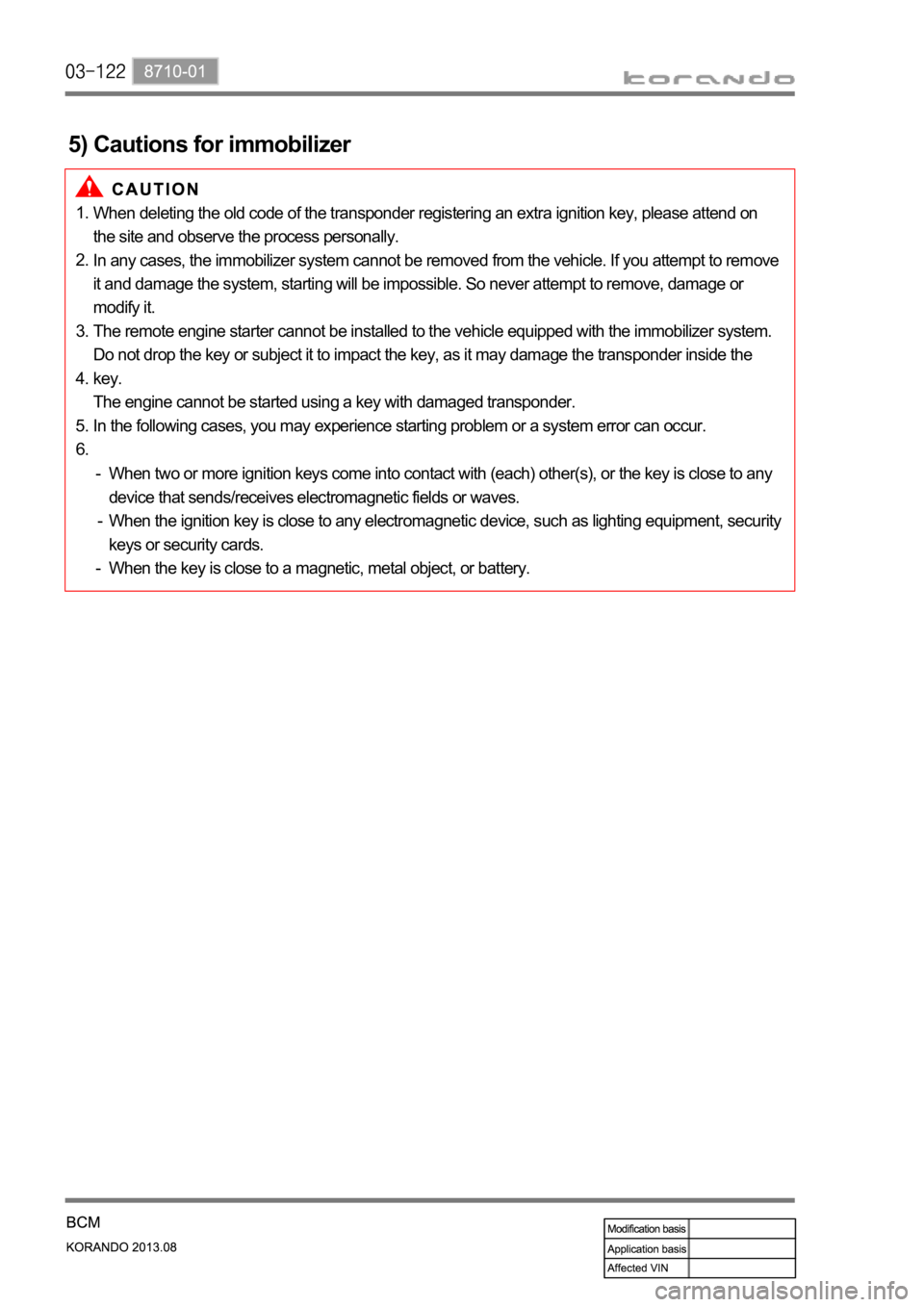
When deleting the old code of the transponder registering an extra ignition key, please attend on
the site and observe the process personally.
In any cases, the immobilizer system cannot be removed from the vehicle. If you attempt to remove
it and damage the system, starting will be impossible. So never attempt to remove, damage or
modify it.
The remote engine starter cannot be installed to the vehicle equipped with the immobilizer system.
Do not drop the key or subject it to impact the key, as it may damage the transponder inside the
key.
The engine cannot be started using a key with damaged transponder.
In the following cases, you may experience starting problem or a system error can occur. 1.
2.
3.
4.
5.
6.
5) Cautions for immobilizer
When two or more ignition keys come into contact with (each) other(s), or the key is close to any
device that sends/receives electromagnetic fields or waves.
When the ignition key is close to any electromagnetic device, such as lighting equipment, security
keys or security cards.
When the key is close to a magnetic, metal object, or battery. -
-
-
Page 758 of 1336
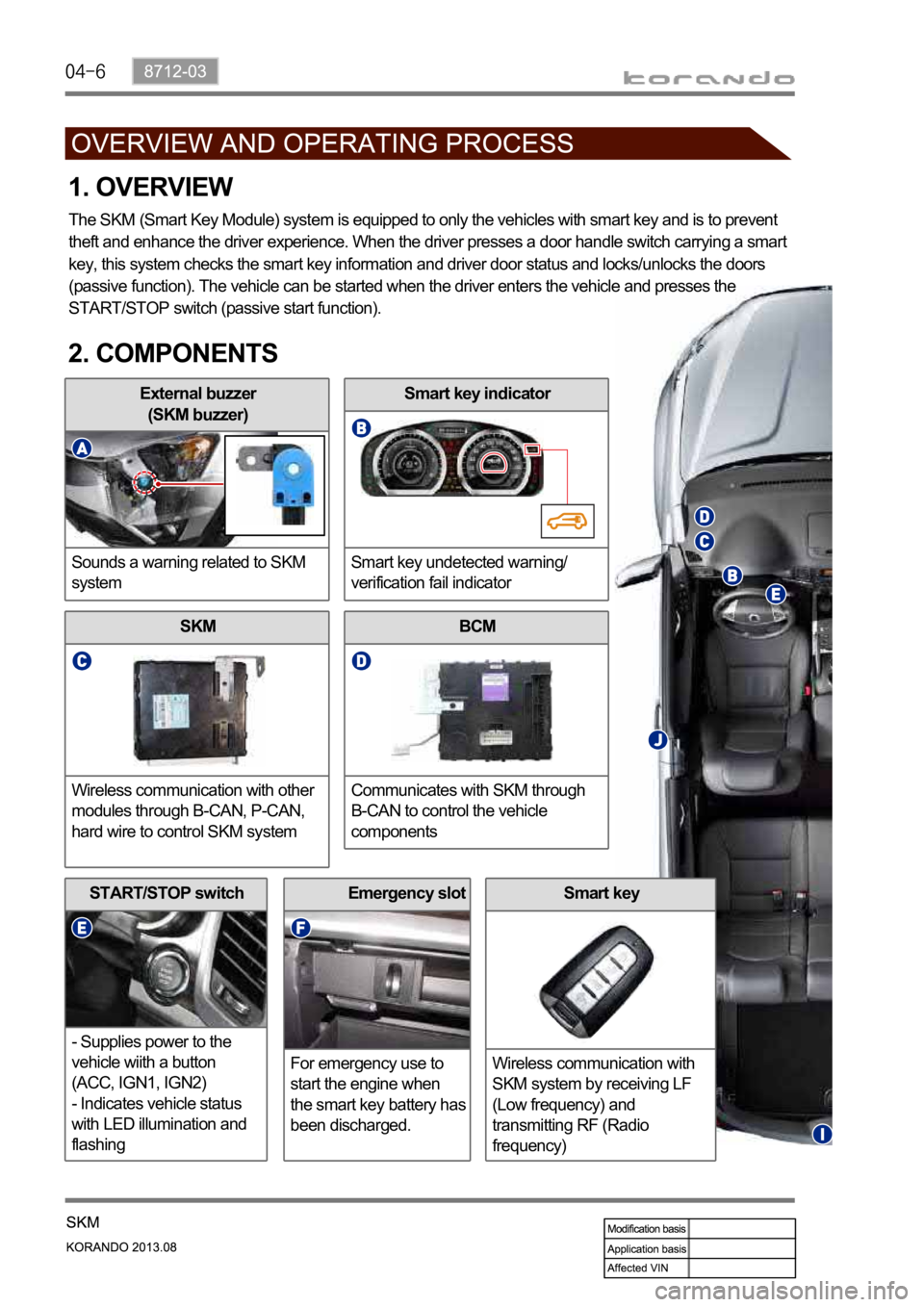
Smart key
Wireless communication with
SKM system by receiving LF
(Low frequency) and
transmitting RF (Radio
frequency)Emergency slot
For emergency use to
start the engine when
the smart key battery has
been discharged.
SKM
Wireless communication with other
modules through B-CAN, P-CAN,
hard wire to control SKM system
External buzzer
(SKM buzzer)
Sounds a warning related to SKM
system
START/STOP switch
- Supplies power to the
vehicle wiith a button
(ACC, IGN1, IGN2)
- Indicates vehicle status
with LED illumination and
flashing
1. OVERVIEW
The SKM (Smart Key Module) system is equipped to only the vehicles with smart key and is to prevent
theft and enhance the driver experience. When the driver presses a door handle switch carrying a smart
key, this system checks the smart key information and driver door status and locks/unlocks the doors
(passive function). The vehicle can be started when the driver enters the vehicle and presses the
START/STOP switch (passive start function).
2. COMPONENTS
Smart key indicator
Smart key undetected warning/
verification fail indicator
BCM
Communicates with SKM through
B-CAN to control the vehicle
components
Page 762 of 1336
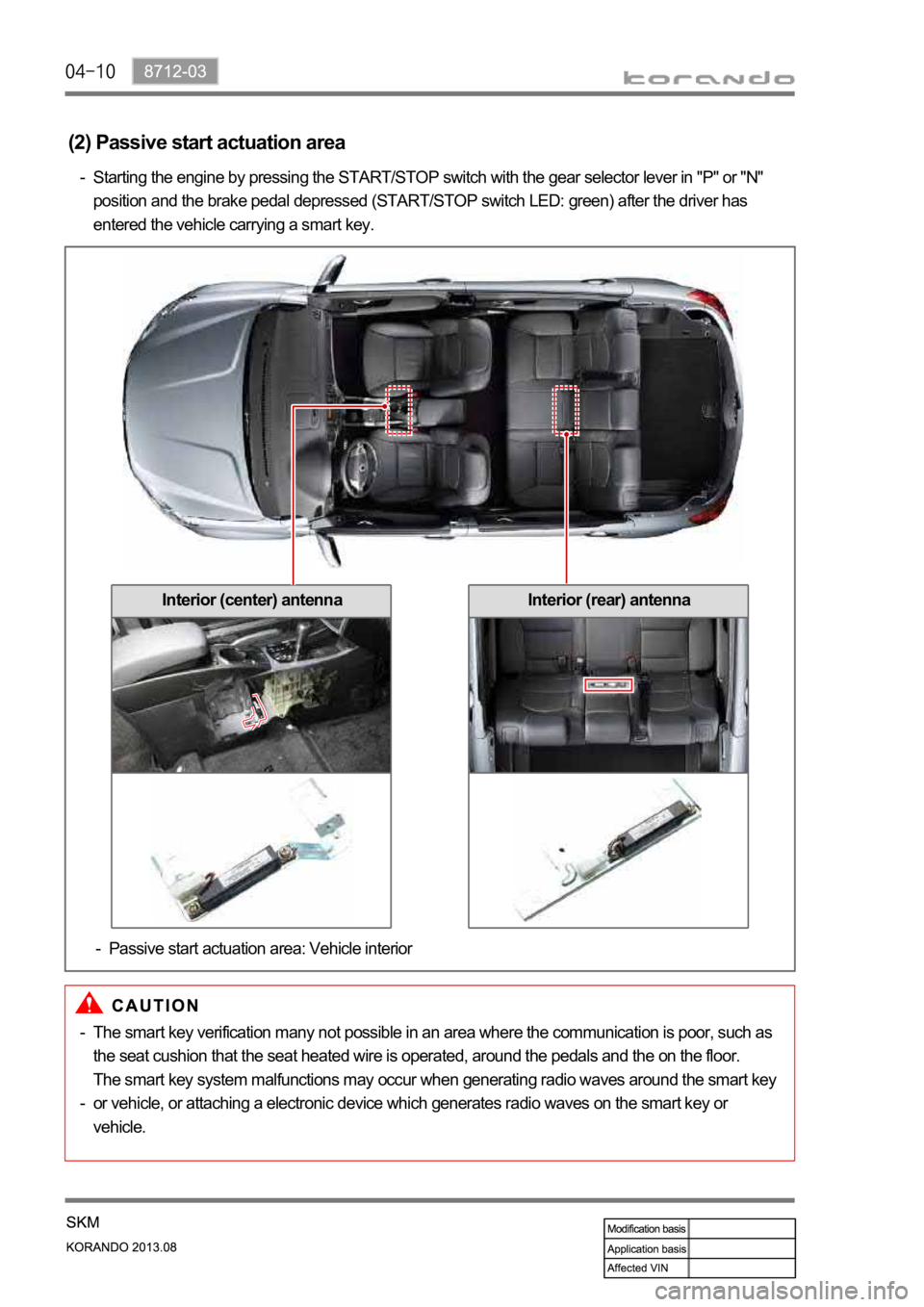
Interior (center) antennaInterior (rear) antenna
The smart key verification many not possible in an area where the communication is poor, such as
the seat cushion that the seat heated wire is operated, around the pedals and the on the floor.
The smart key system malfunctions may occur when generating radio waves around the smart key
or vehicle, or attaching a electronic device which generates radio waves on the smart key or
vehicle. -
-
(2) Passive start actuation area
Starting the engine by pressing the START/STOP switch with the gear selector lever in "P" or "N"
position and the brake pedal depressed (START/STOP switch LED: green) after the driver has
entered the vehicle carrying a smart key. -
Passive start actuation area: Vehicle interior -
Page 771 of 1336
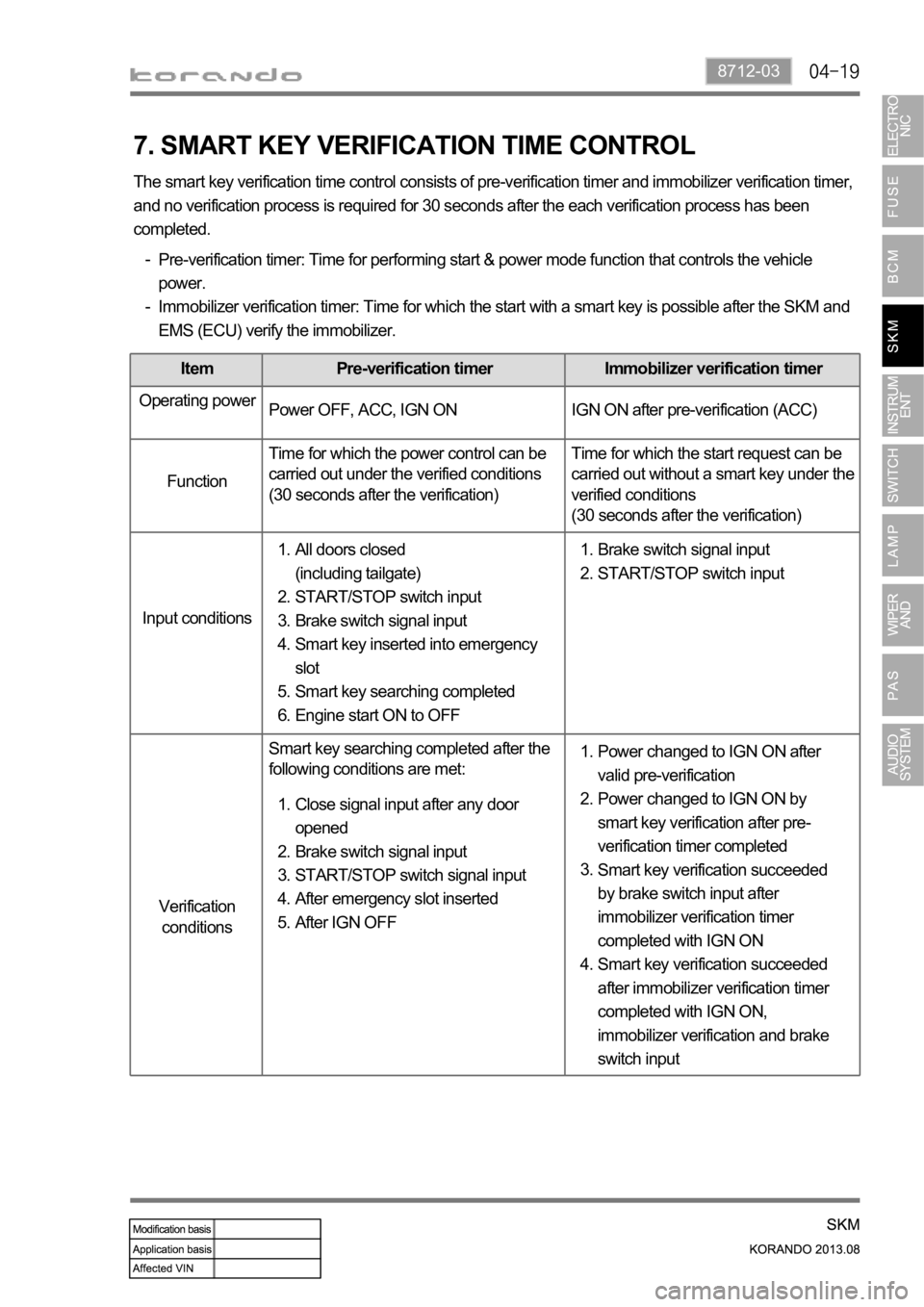
8712-03
7. SMART KEY VERIFICATION TIME CONTROL
The smart key verification time control consists of pre-verification timer and immobilizer verification timer,
and no verification process is required for 30 seconds after the each verification process has been
completed.
Pre-verification timer: Time for performing start & power mode function that controls the vehicle
power.
Immobilizer verification timer: Time for which the start with a smart key is possible after the SKM and
EMS (ECU) verify the immobilizer. -
-
Item Pre-verification timer Immobilizer verification timer
Operating power
Power OFF, ACC, IGN ON IGN ON after pre-verification (ACC)
FunctionTime for which the power control can be
carried out under the verified conditions
(30 seconds after the verification)Time for which the start request can be
carried out without a smart key under the
verified conditions
(30 seconds after the verification)
Input conditions
Verification
conditionsSmart key searching completed after the
following conditions are met:
Close signal input after any door
opened
Brake switch signal input
START/STOP switch signal input
After emergency slot inserted
After IGN OFF 1.
2.
3.
4.
5.Power changed to IGN ON after
valid pre-verification
Power changed to IGN ON by
smart key verification after pre-
verification timer completed
Smart key verification succeeded
by brake switch input after
immobilizer verification timer
completed with IGN ON
Smart key verification succeeded
after immobilizer verification timer
completed with IGN ON,
immobilizer verification and brake
switch input 1.
2.
3.
4. All doors closed
(including tailgate)
START/STOP switch input
Brake switch signal input
Smart key inserted into emergency
slot
Smart key searching completed
Engine start ON to OFF 1.
2.
3.
4.
5.
6.Brake switch signal input
START/STOP switch input 1.
2.
Page 772 of 1336
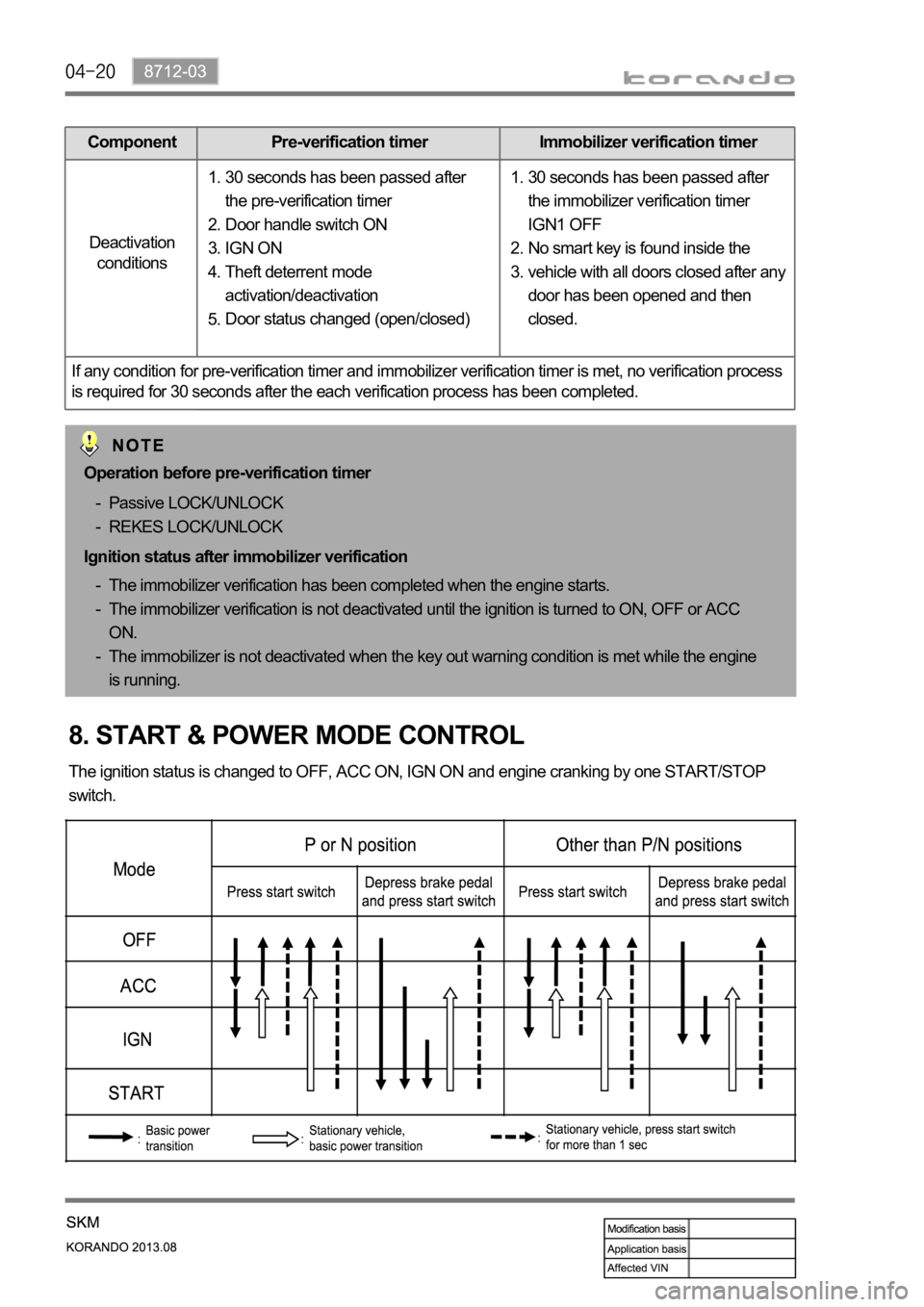
Component Pre-verification timer Immobilizer verification timer
Deactivation
conditions
If any condition for pre-verification timer and immobilizer verification timer is met, no verification process
is required for 30 seconds after the each verification process has been completed.
Operation before pre-verification timer
Passive LOCK/UNLOCK
REKES LOCK/UNLOCK -
-
Ignition status after immobilizer verification
The immobilizer verification has been completed when the engine starts.
The immobilizer verification is not deactivated until the ignition is turned to ON, OFF or ACC
ON.
The immobilizer is not deactivated when the key out warning condition is met while the engine
is running. -
-
-
8. START & POWER MODE CONTROL
The ignition status is changed to OFF, ACC ON, IGN ON and engine cranking by one START/STOP
switch.30 seconds has been passed after
the immobilizer verification timer
IGN1 OFF
No smart key is found inside the
vehicle with all doors closed after any
door has been opened and then
closed. 1.
2.
3. 30 seconds has been passed after
the pre-verification timer
Door handle switch ON
IGN ON
Theft deterrent mode
activation/deactivation
Door status changed (open/closed) 1.
2.
3.
4.
5.
Page 773 of 1336

8712-03
Power control and engine start diagram
Page 774 of 1336
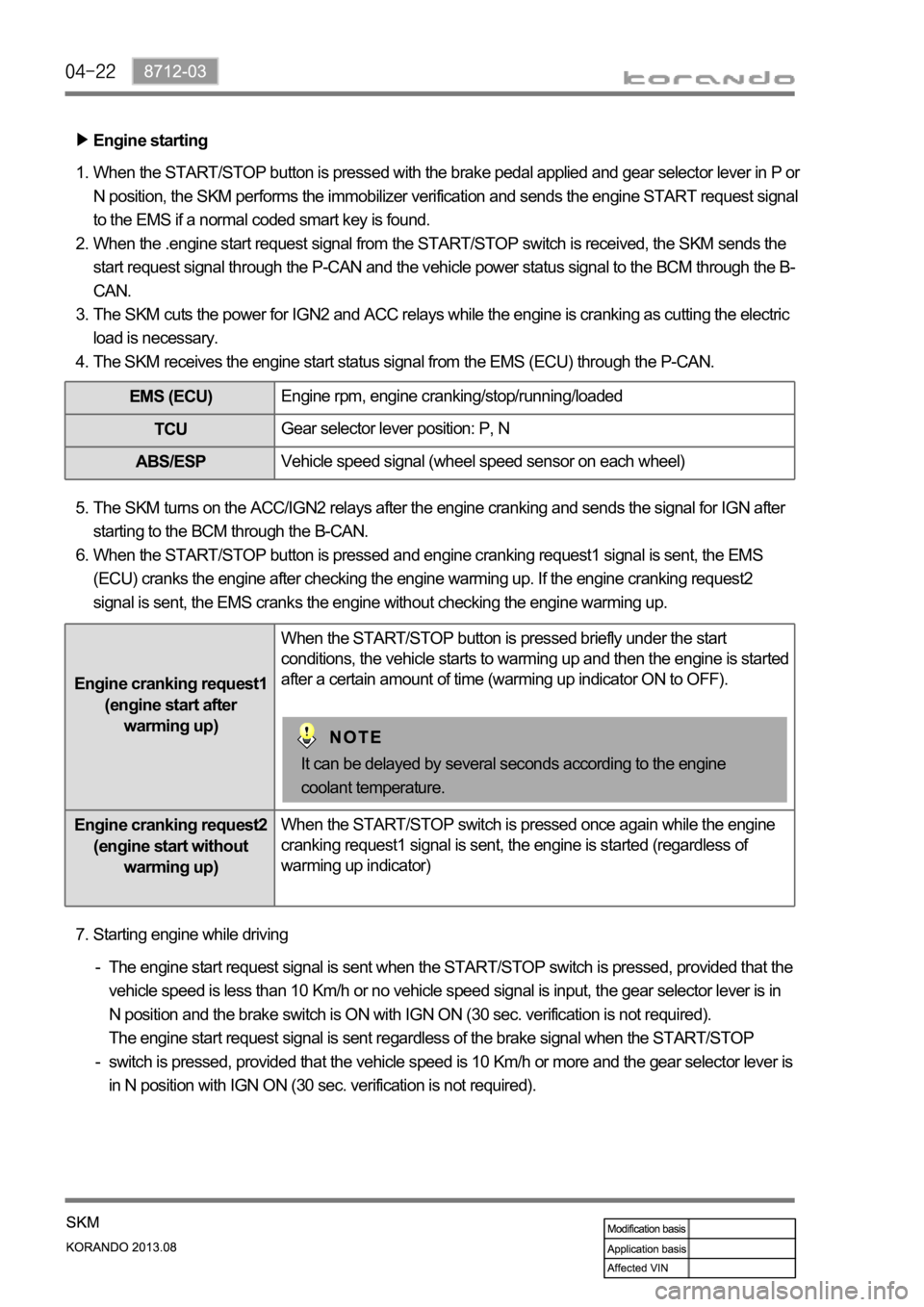
Engine starting
When the START/STOP button is pressed with the brake pedal applied and gear selector lever in P or
N position, the SKM performs the immobilizer verification and sends the engine START request signal
to the EMS if a normal coded smart key is found.
When the .engine start request signal from the START/STOP switch is received, the SKM sends the
start request signal through the P-CAN and the vehicle power status signal to the BCM through the B-
CAN.
The SKM cuts the power for IGN2 and ACC relays while the engine is cranking as cutting the electric
load is necessary.
The SKM receives the engine start status signal from the EMS (ECU) through the P-CAN. 1.
2.
3.
4.
EMS (ECU)Engine rpm, engine cranking/stop/running/loaded
TCUGear selector lever position: P, N
ABS/ESPVehicle speed signal (wheel speed sensor on each wheel)
The SKM turns on the ACC/IGN2 relays after the engine cranking and sends the signal for IGN after
starting to the BCM through the B-CAN.
When the START/STOP button is pressed and engine cranking request1 signal is sent, the EMS
(ECU) cranks the engine after checking the engine warming up. If the engine cranking request2
signal is sent, the EMS cranks the engine without checking the engine warming up. 5.
6.
Engine cranking request1
(engine start after
warming up)When the START/STOP button is pressed briefly under the start
conditions, the vehicle starts to warming up and then the engine is started
after a certain amount of time (warming up indicator ON to OFF).
Engine cranking request2
(engine start without
warming up)When the START/STOP switch is pressed once again while the engine
cranking request1 signal is sent, the engine is started (regardless of
warming up indicator)
It can be delayed by several seconds according to the engine
coolant temperature.
Starting engine while driving 7.
The engine start request signal is sent when the START/STOP switch is pressed, provided that the
vehicle speed is less than 10 Km/h or no vehicle speed signal is input, the gear selector lever is in
N position and the brake switch is ON with IGN ON (30 sec. verification is not required).
The engine start request signal is sent regardless of the brake signal when the START/STOP
switch is pressed, provided that the vehicle speed is 10 Km/h or more and the gear selector lever is
in N position with IGN ON (30 sec. verification is not required). -
-
Page 775 of 1336
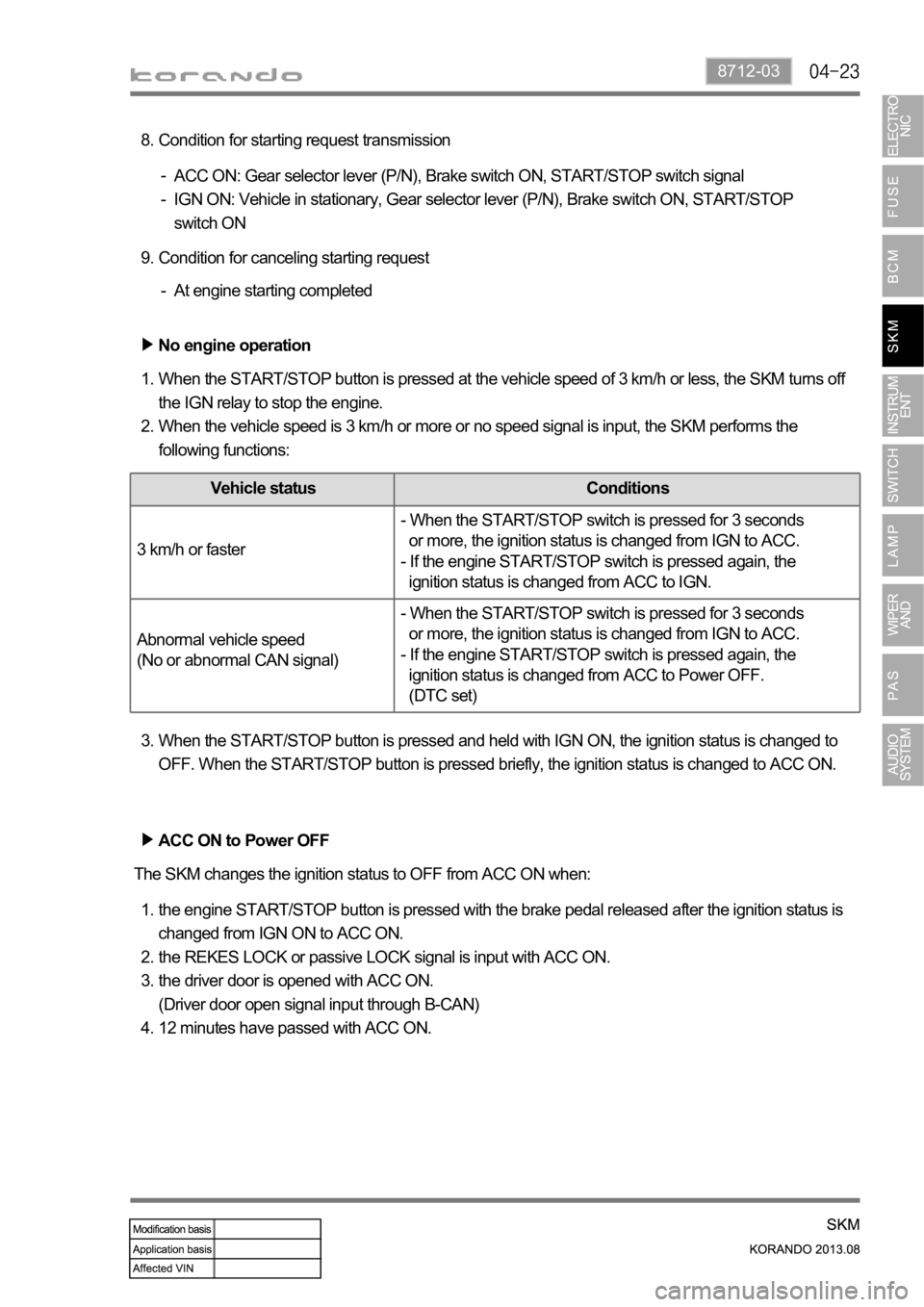
8712-03
No engine operation
When the START/STOP button is pressed at the vehicle speed of 3 km/h or less, the SKM turns off
the IGN relay to stop the engine.
When the vehicle speed is 3 km/h or more or no speed signal is input, the SKM performs the
following functions: 1.
2.
Vehicle status Conditions
3 km/h or faster - When the START/STOP switch is pressed for 3 seconds
or more, the ignition status is changed from IGN to ACC.
- If the engine START/STOP switch is pressed again, the
ignition status is changed from ACC to IGN.
Abnormal vehicle speed
(No or abnormal CAN signal)- When the START/STOP switch is pressed for 3 seconds
or more, the ignition status is changed from IGN to ACC.
- If the engine START/STOP switch is pressed again, the
ignition status is changed from ACC to Power OFF.
(DTC set)
When the START/STOP button is pressed and held with IGN ON, the ignition status is changed to
OFF. When the START/STOP button is pressed briefly, the ignition status is changed to ACC ON. 3.
ACC ON to Power OFF
The SKM changes the ignition status to OFF from ACC ON when:
the engine START/STOP button is pressed with the brake pedal released after the ignition status is
changed from IGN ON to ACC ON.
the REKES LOCK or passive LOCK signal is input with ACC ON.
the driver door is opened with ACC ON.
(Driver door open signal input through B-CAN)
12 minutes have passed with ACC ON. 1.
2.
3.
4.Condition for starting request transmission 8.
ACC ON: Gear selector lever (P/N), Brake switch ON, START/STOP switch signal
IGN ON: Vehicle in stationary, Gear selector lever (P/N), Brake switch ON, START/STOP
switch ON -
-
Condition for canceling starting request 9.
At engine starting completed -